
You don’t have to be a data scientist in order to know how to analyze survey data. All you need to know are some impeccable methods that can get the job done.
Even a small survey shared with your audience can offer an overwhelming amount of data and leave your team feeling anxious. How do you join the dots and make sense of it all?
An online survey tools can help you create a survey and share it on the right distribution channels.
However, when the survey data comes back in, how do you use it for the benefit of different teams – sales, marketing, product, etc.? How do you turn raw numbers into actionable insights?
Effectively analyzing this treasure trove of data is crucial to give your employees valuable insights into customer behavior and identify the major trends prevalent in the market. In this blog, we will explore the top methods to analyze survey results and make data-backed decisions.
Let’s go!
8 Effective Ways to Analyze Survey Data
There is no use of data when it is just lying around. You need to have proper methods in place to see the bigger picture. Here are the top eight survey analysis methods you can consider:
1. Understand the Measurement Scales
Survey analysis is not possible without really understanding the scales. As we know, survey data can be divided into qualitative and quantitative data. While qualitative data encompasses open-ended questions and does not require a numerical scale, quantitative questions require numerical scales. So let’s take a look at the measurement scales used in surveys.
(a) Nominal scales: These are used to classify qualitative data. These are similar to labels as the choices available are not directly related to each other. These are apt for questions like, “Which phone brands have you used?”
Nominal scales don’t have numerical values and are mainly used to analyze the preferences of people. It helps you keep track of the number of people who picked a similar option.
(b) Ordinal scales: This scale is used to rank options based on the order of preferences. Something as simple as “In order of preference, who do you think is most likely to win the current NBA season?” Combining the data with cross-tabulation analysis can help you analyze two sets of correlated data. We’ll take a better look at cross-tabulation in the next part of the article.
(c) Interval scales: When participants are required to record an answer that falls somewhere along with a pre-ordained range, that’s where the interval scale helps. The best example of interval scales would be price filters. Here is an example, “How much would you pay for this product?”
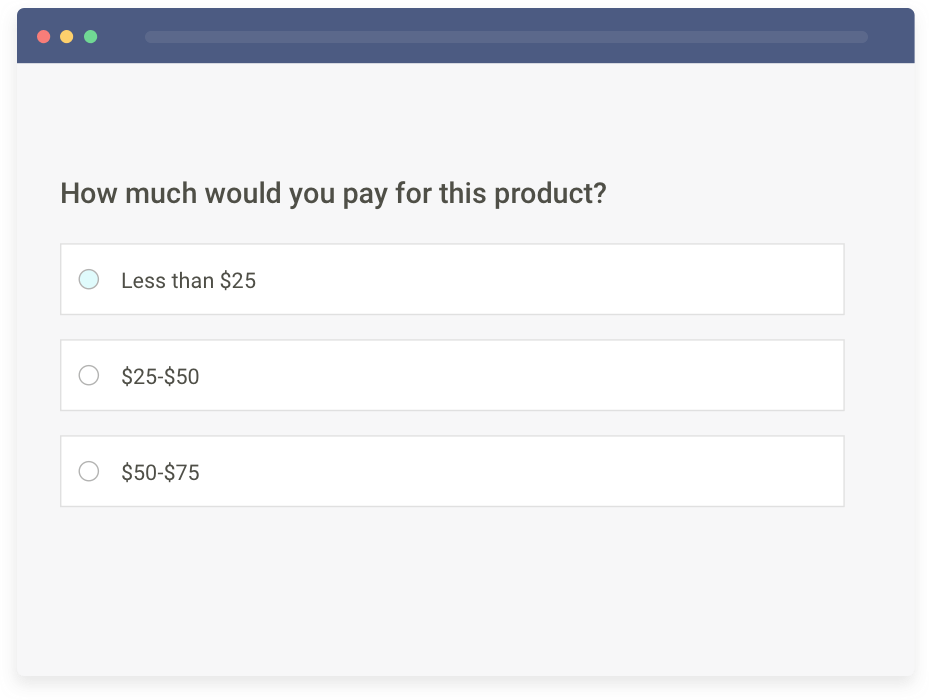
(d) Ratio Scales: Ratios scales are similar to interval scales in function and purpose. The only difference between the two being that ratio scales start at zero. An example of this would be: “How often do you work out in a week?“
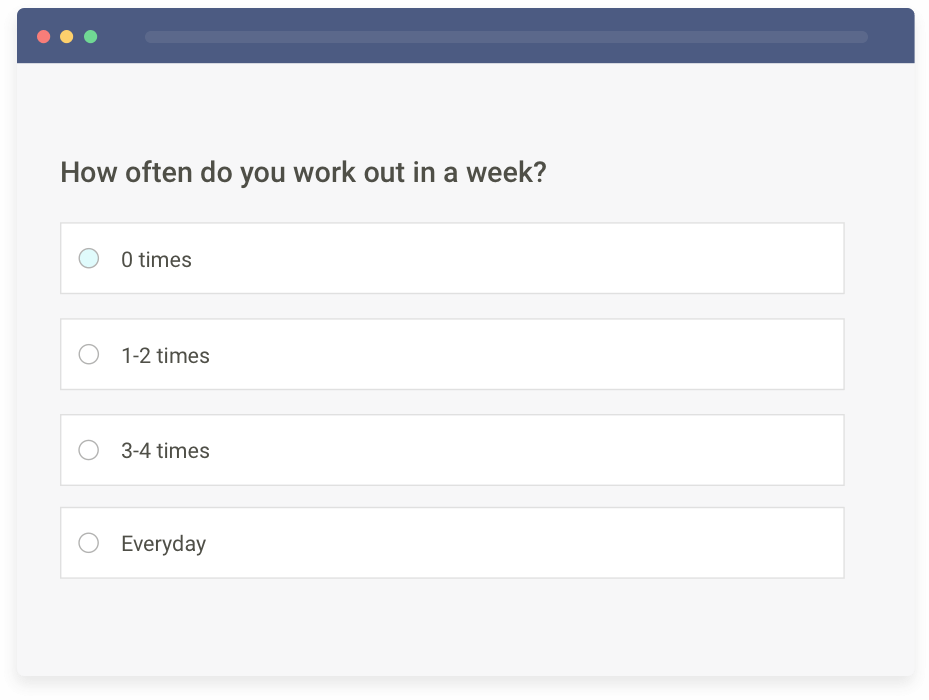
2. Start With the Quantitative Questions
Your survey analysis should begin with quantitative questions first. Since the responses to these questions are based on statistics and numbers, you can easily analyze and draw conclusions from this data.
Take your Net Promoter Score (NPS) results, for example. NPS questions offer a 0-10 rating scale to understand the likelihood of customers recommending your brand/product/service to others. You can use survey analytics to evaluate the ratings provided. Whether you receive responses from ten customers or a thousand, you can easily identify your brand promoters.
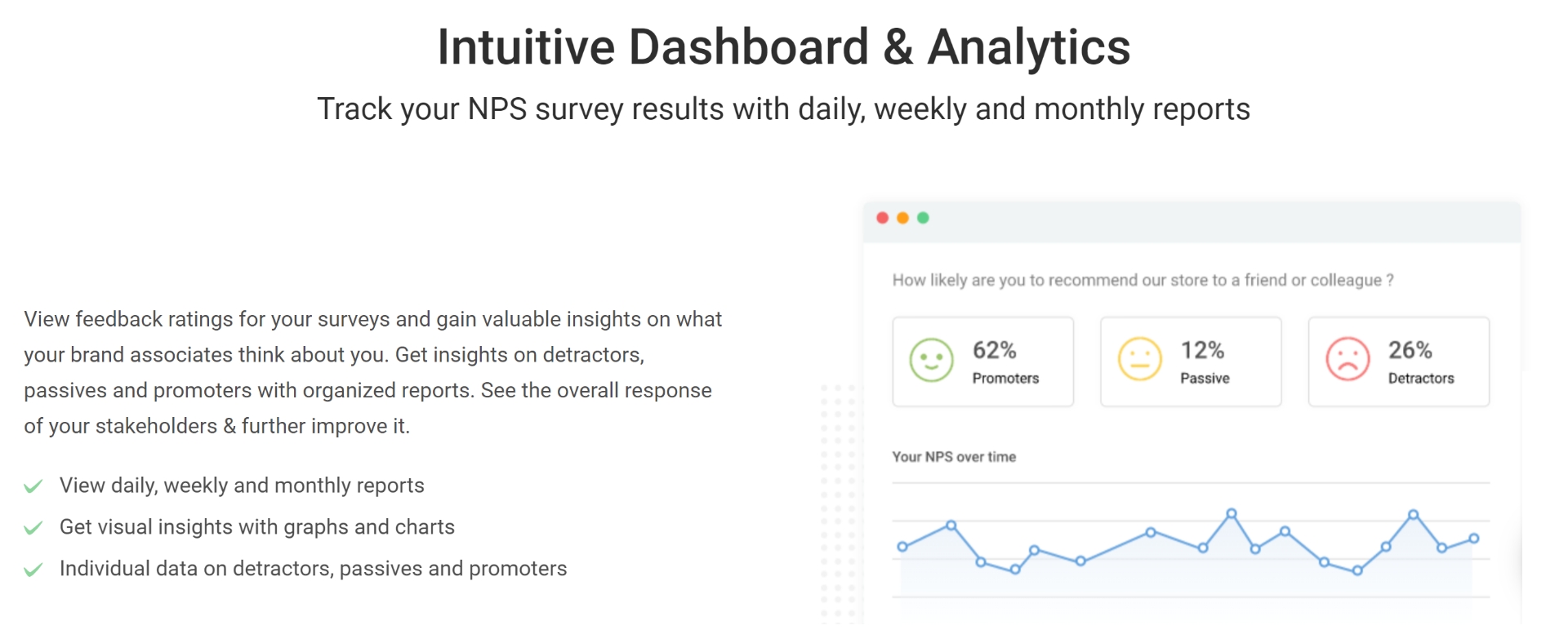
You can then refer to the previous results to know whether your customer loyalty score has increased or decreased. Now that you have a general idea of your results, you can form a plan to improve your Net Promoter Score.
3. Pay Attention to Qualitative Responses
Qualitative data refers to the descriptive feedback provided by people who took your survey. Such responses are shared for open-ended questions and can differ from one person to another.
For example, here is an open-ended question, “What makes you connect with our brand?” Now, If you ask this question to ten people, you might get 10 different answers. So how do you analyze survey data in this case?
Here are some ways to analyze qualitative survey data:
Make a visual representation: Take a careful look at each and every survey response and identify common keywords. Taking the same question forward, you might find keywords such as style, market dominance, quality, etc. You can note down these keywords and communicate this to the necessary departments.
Focus on individual responses for a personalized experience: Imagine you ask the question, “What areas do you want us to improve upon?”. The answers to this question will help you understand what individual customers expect from your brand and how you can meet their expectations to improve the customer experience.
4. Consider Using Cross-Tabulation Analysis
Cross tabulation enables you to understand the relationship between independent variables. Frequently your survey responses will include responses from people who do not ideally fit your target audience. This could result in your survey results being skewed towards one opinion or the other or just being generally irrelevant.
Say you’re planning on opening a gym, and you place a survey on your website asking people how often they work out.
Now, you would prefer the data mainly for the people residing in New York, aged between 18-35, as they are your primary target audience. But since your website and the survey will be visible to everyone, you will be receiving responses from people all around the country.
Cross-tabulation analysis can help filter out the data for people aged between 18-35 currently living in New York.
5. Understand Correlation vs. Causation
The human mind is adept at finding patterns between events. This often leads to linking two independent events as mutually inclusive, even though they may exist independently of each other. This can often lead to unnecessary biases.
An article published by Harvard Business Review shows how easy it is to misrepresent data by correlating two independent variables. The article presents a graph showing how iPhone sales and deaths caused by falling from the stairs had increased since 2010. Connecting these two can lead you to believe that – More iPhones in the market mean more people are falling from the stairs.
That is certainly not the case. There exist other factors that determine these results. If you just go by the correlation between two variables, chances are you will arrive at an inaccurate result.
Therefore, you must analyze all sides of the story and identify all the variables before drawing your conclusions.
6. Compare Survey Data Against Past Results
Your business must have already shared several rounds of surveys in the past and made necessary reports after getting the results. Do you keep these reports handy or throw them after a while?
One of the best ways for analyzing survey data is to study them against these past results. Let’s understand this better with an example.
Let’s assume you share quarterly NPS surveys. While the current results keep you updated, comparing them against last quarter’s results shows whether your performance has improved or not. After all, no team wants to be in the same place forever. If you had 30% promoters in the previous quarter and now you have 40% promoters, it shows an overall trend of increasing customer loyalty. This will also be evident in more product recommendations and increased sales.
7. Use Industry Benchmarks for Better Comparison
Every business out there is competing with hundreds of competitors who sell similar products and target the same audience. In such a situation, it is important to understand industry benchmarks and compare your survey results with them.
During your survey data analysis process, it can be difficult to understand if the numbers are good or bad. You might have improved since your last survey, but are you meeting industry standards?
For example, while CSAT scores vary by industry, a good score usually falls between 75% to 85%. So even if your business improved its CSAT score in a year and got to 50%, you are still quite far from reaching the industry benchmark. After all, if you wish to survive in the competitive business world and retain customers, you need to aim for the best.
Therefore, benchmarking allows you to interpret your survey results in a meaningful manner, offers you a clearer picture, and helps you measure the real success of your efforts.
8. Avoid Considering Incorrect or Incomplete Responses
It is common for people to leave your survey midway and submit incomplete surveys. Maybe they are just in a hurry or find the survey questions too personal or uninteresting.
When your survey asks multiple questions, It is natural for some people to skip certain questions or reply incorrectly. For instance, when you ask the open-ended question, “Which brands come to your mind when you think of soft drinks?” Some customers might give out-of-context replies such as “Yes”, “Coffee”, “Soft drinks are unhealthy”, etc.
Such responses can lead to poor survey analysis. As a result, you need to avoid using them for your study and instead encourage your audience to fill your surveys attentively.
But who are these inattentive survey respondents?
Inattentive survey respondents can be divided into four categories. To make the most of your surveys, you need to spot them early:
Speeders: These are people who speed up through your surveys, answering some questions while leaving others. They are the quickest when it comes to survey completion.
Straightliners: These are people who offer the same answer for almost every question. For instance, they will respond “Agree” to every question.
Slackers: These are people who lack the motivation to complete your survey or offer their opinions. You can spot slackers by the quality of their responses.
Imposters: Imposters are people who pretend to be someone else while responding to a survey. They might share false demographic information to win the perks of completing a survey.
Now that brings us to the end of survey data analysis methods. What next? Presenting the survey data and results in an acceptable and pleasing manner to the other stakeholders is equally important.
How to Present Survey Data
A solid presentation of survey results helps you easily spot trends, identify important metrics, and arrive at the right conclusions. If you are looking for ways to present survey data to share insights with team members and other stakeholders, you have come to the right place. Here are some popular ways to present your survey data:
Graphs: Graphs are one of the most visually appealing survey data analysis methods. Not only are they easy on the eye, but they also help simplify complex data and make it easy to understand for the viewer. Depending on the type of data collected, you can choose to present your data as:
- Pie charts
- Venn diagrams
- Scatter plots
- Histograms
- Pictograms
Make sure that you pick the graph that best depicts the data to all readers.
Data Tables: Data tables are an excellent way to share numerical data. You can use Excel and other similar software to display data.
Presentations: Presentations allow you to present your findings in a mix of textual and graphical data. This helps you present the earlier stages of your survey, including the research questions, the hypothesis, and the methods used for survey results analysis.
Infographics: If you want to present your data in an easy to consume manner for your customers, infographics are your best option. This helps you present the survey results as statistics and adds to your website’s visual UI.
Reports: When it comes to investor or shareholder meetings, presentations and data tables may not always be the best option as the relevant personnel would like an in-depth study of the whole process. You could hand the report out while you present your data in the manner you prefer. While you may not directly quote from the report, anyone with doubts or questions regarding the data can refer to the report for clarification.

How to Analyze Survey Data Using Online Survey Tool
Survey responses, if not arranged properly, can seem like a cryptic message that is impossible to decode. However, thanks to online survey tools, you do not have to waste time manually sorting responses.
ProProfs Survey Maker makes it easier for you to understand your survey data and make sense of it. Let’s see how this works.
As soon as you log in, you can access “Recent Activity Reports”. This helps you see the latest activities across all your surveys at a glance and saves you valuable time.
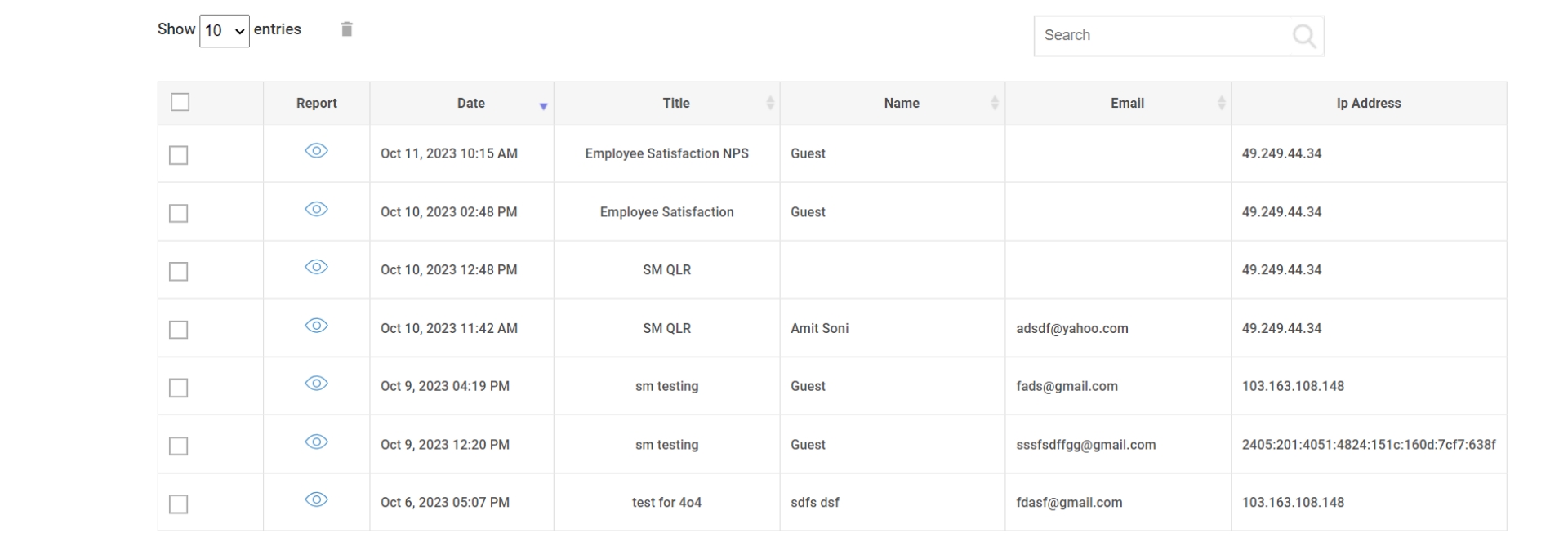
For in-depth reports and survey analytics, you can choose a particular survey and click on Reports. Here you can check the attempt date, the response, score, name and contact details of the respondent, and much more. You can easily download these reports or share them with key stakeholders using a link.

To get a clear picture of your survey data, you can go to Survey Stats. This provides you with a range of data regarding the performance of your surveys. Right from the number of people who took the survey to the average score, stats reveal everything. The best part is that you can sort the survey statistics according to days, weeks, months, or enter your preferred dates.
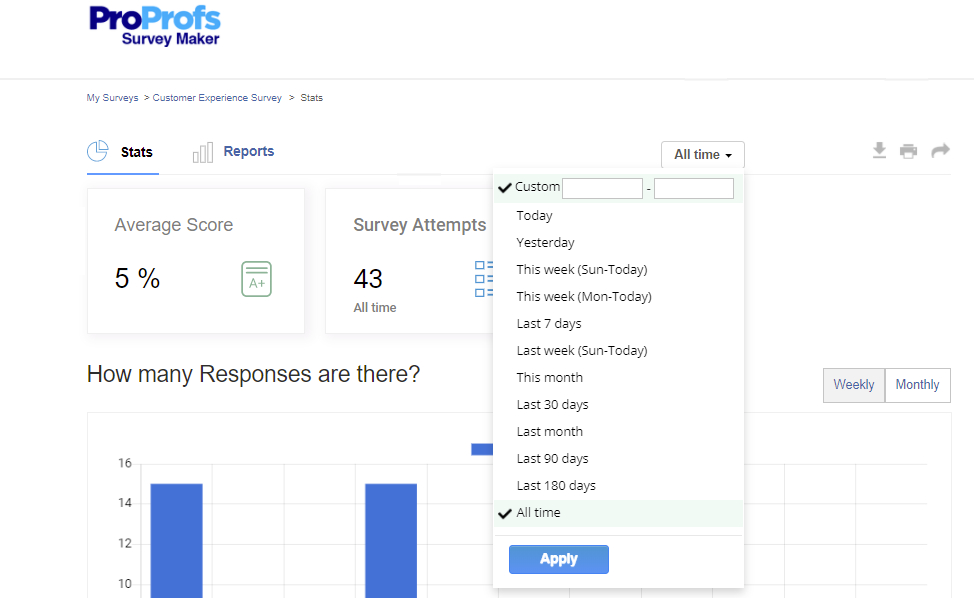
Turn Survey Data into Meaningful Insights
Collecting customer feedback has always been an integral part of any successful business. But sharing surveys is only half the battle. To implement customer feedback and make necessary adjustments, you need to learn how to analyze survey data.
Follow the methods shared in this blog to collect survey data, decode and evaluate it, and finally arrive at meaningful conclusions. For best results, remember to compare survey data with past results and also with industry benchmarks.
Don’t forget to add a survey creation tool like ProProfs Survey Maker to your arsenal. It has got all you need to create a survey, analyze them, and draw actionable insights to identify trends and understand customer behavior.
FREE. All Features. FOREVER!
Try our Forever FREE account with all premium features!







